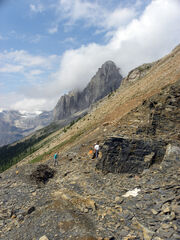
Walcott Quarry in the Burgess Shale
The Burgess Shale is a Cambrian-age fossil field located in British Columbia. It is famous for its preservation of soft body parts in several different types of early arthropods and other invertebrates.[1]
Geology[]
The Burgess Shale is part of the Stephen Formation, a Middle Cambrian-age rock unit dating back to about 505 million years of age.[2] It is composed largely of a black shale, and was deposited at the base of a large cliff (composed of rocks from a slightly earlier formation) under the ocean.[3] The rocks of this cliff were difficult to compress, leading to the quality preservation of the Burgess Shale fossils.
Although it was originally believed that the Burgess Shale was deposited in anoxic conditions, which was thought to explain the quality of fossil preservation, but there is growing evidence that oxygen was abundant in the area's water.[4]
History[]
Paleontologist Charles Walcott first discovered the Burgess Shale in 1909, and by 1924 he had collected over 65,000 specimens from the locality. The fossils were not seen as particularly unusual until the 1960s, when it became clear that most were not part of any extant group of animals.[5]
The Burgess Shale was first brought to public attention in 1989, when Stephen Jay Gould published the book Wonderful Life, which focused on the anatomy and evolution of the fossils found there.[6]
Biota[]
A wide variety of fauna has been discovered in the Burgess Shale, most of which is completely unlike animals that live in the modern day. Genera include:
- Anomalocaris
- Aysheaia
- Canadaspis
- Hallucigenia
- Marrella
- Nectocaris
- Opabinia
- Ottoia
- Peytoia
- Pikaia
- Sanctacaris
- Vauxia
- Wiwaxia
Go to List of Burgess Shale biota by phylum for all of the Burgess Shale species
References[]
- ↑ Gabbott, Sarah E. (2001). "Exceptional Preservation". Encyclopedia of Life Sciences. doi:10.1038/npg.els.0001622.
- ↑ Butterfield, N.J. (2006). "Hooking some stem-group" worms": fossil lophotrochozoans in the Burgess Shale". Bioessays 28 (12): 1161–6. doi:10.1002/bies.20507. PMID 17120226.
- ↑ Gabbott, S.E.; Zalasiewicz, J.; Collins, D. (2008). "Sedimentation of the Phyllopod bed within the Cambrian Burgess Shale Formation of British Columbia". Journal of Geological Society 165 (1): 307. doi:10.1144/0016-76492007-023.
- ↑ Powell, W. (2009). "Comparison of Geochemical and Distinctive Mineralogical Features Associated with the Kinzers and Burgess Shale Formations and their Associated Units". Palaeogeography Palaeoclimatology Palaeoecology 277 (1–2): 127–140. doi:10.1016/j.palaeo.2009.02.016.
- ↑ Briggs, D.E.G.; Erwin, D.H.; Collier, F.J. (1995), Fossils of the Burgess Shale, Washington: Smithsonian Inst Press, ISBN 156098659x, OCLC 231793738
- ↑ Knoll, A.H. (2004). "Cambrian Redux". The First Three Billion Years of Evolution on Earth. Princeton University Press. p. 192. ISBN 978-0-691-12029-4. Retrieved 2009-04-22.